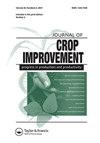Efficacy of maize inbred testers with varying levels of resistance to Striga for classifying Striga-resistant yellow-maize lines into heterotic groups
IF 1.5
Q3 AGRONOMY
引用次数: 1
Abstract
ABSTRACT Identifying efficient testers for separating maize (Zea mays L.) inbred lines into heterotic groups can facilitate the development of superior hybrids. Striga-resistant yellow-maize inbred lines developed at the International Institute of Tropical Agriculture (IITA) do not have well established heterotic groups. This study was conducted to identify efficient testers for classifying yellow-maize inbred lines into heterotic groups. Thirty Striga-resistant inbred lines were crossed with three testers having varying levels of resistance to Striga. A trial comprising 90 testcrosses and two hybrid checks was conducted at two locations in Nigeria for 2 years under Striga-infested and non-infested conditions. The approach that involved specific combining ability (SCA) effects and mean grain yields was found to be more efficient than the heterotic group’s specific and general combining ability (HSGCA) grouping method in separating the 30 inbred lines into three heterotic groups. The tolerant and resistant testers were highly efficient in grouping the inbred lines into heterotic groups under Striga-infested and non-infested conditions using the two approaches. Striga-resistant yellow inbred lines assigned to two of the three major heterotic groups could be used as parents for developing superior hybrids and/or synthetics and for generating source populations for developing new maize inbred lines.不同抗Striga水平的玉米自交系试验者将抗Striga的黄玉米品系分为杂种群的效果
摘要鉴定高效的玉米自交系杂种优势群体分离试剂,有助于培育优良杂交种。国际热带农业研究所(IITA)开发的抗曲菌黄玉米自交系没有建立良好的杂种优势群体。本研究旨在寻找一种有效的黄玉米自交系杂种优势类群划分方法。30个抗斯特riga自交系与三个对斯特riga具有不同程度抗性的测试者杂交。在尼日利亚的两个地点进行了为期2年的试验,其中包括90个杂交试验和2个杂交试验,分别在striga侵染和非侵染的条件下进行。将30个自交系划分为3个杂种优势群体时,结合特定配合力(SCA)效应和平均产量的方法比杂种优势群体的特定配合力和一般配合力(HSGCA)分组方法更有效。两种方法均能有效地将自交系在曲曲菌侵染和非曲曲菌侵染条件下划分为杂种优势群体。3个主要杂种优势群体中的2个具有抗曲菌性的黄色自交系可作为培育优良杂交种和/或合成材料的亲本,也可作为培育新的玉米自交系的源群体。
本文章由计算机程序翻译,如有差异,请以英文原文为准。
求助全文
约1分钟内获得全文
求助全文
来源期刊

Journal of Crop Improvement
Multiple-
CiteScore
3.30
自引率
7.70%
发文量
42
期刊介绍:
Journal of Crop Science and Biotechnology (JCSB) is a peer-reviewed international journal published four times a year. JCSB publishes novel and advanced original research articles on topics related to the production science of field crops and resource plants, including cropping systems, sustainable agriculture, environmental change, post-harvest management, biodiversity, crop improvement, and recent advances in physiology and molecular biology. Also covered are related subjects in a wide range of sciences such as the ecological and physiological aspects of crop production and genetic, breeding, and biotechnological approaches for crop improvement.
 求助内容:
求助内容: 应助结果提醒方式:
应助结果提醒方式:


